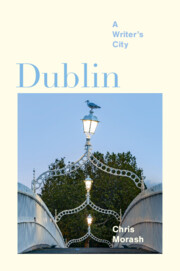Book contents
- Dublin
- Imagining Cities
- Dublin
- Copyright page
- Dedication
- Contents
- A Writer’s City: Series Preface
- Chronology
- Additional material
- Introduction The Imagined City in Time of Pandemic
- 1 Mapping the City
- 2 Baggotonia
- 3 Around St. Stephen’s Green
- 4 Trinity College
- 5 Around the Liberties
- 6 O’Connell Street and the Abbey Theatre
- 7 The North Inner City
- 8 South Dublin
- 9 The South Coast
- 10 North Dublin
- 11 Riverrun
- Read On …
- Notes
- Bibliography
- Acknowledgements
- Index
- Plate Section
5 - Around the Liberties
Published online by Cambridge University Press: 16 February 2023
- Dublin
- Imagining Cities
- Dublin
- Copyright page
- Dedication
- Contents
- A Writer’s City: Series Preface
- Chronology
- Additional material
- Introduction The Imagined City in Time of Pandemic
- 1 Mapping the City
- 2 Baggotonia
- 3 Around St. Stephen’s Green
- 4 Trinity College
- 5 Around the Liberties
- 6 O’Connell Street and the Abbey Theatre
- 7 The North Inner City
- 8 South Dublin
- 9 The South Coast
- 10 North Dublin
- 11 Riverrun
- Read On …
- Notes
- Bibliography
- Acknowledgements
- Index
- Plate Section
Summary
Dublin’s origins as a city are Viking, and the buried remains of this era can be found near the site of Christchurch Cathedral, where the now covered-over River Poddle ran down to the Liffey. It was here that the original medieval city grew up around the administrative centre of Dublin Castle, adjacent to which the city’s first theatres in the seventeenth century – notably Smock Alley – would be built. This chapter takes as its keynote the idea of a buried past making itself felt in the present in literature.This extends from contemporary crime fiction by Tanya French and classic nineteenth-century gothic fiction by Sheridan Le Fanu, to poetry and theatre about the Northern Ireland conflict by Seamus Heaney and Brian Friel that finds a metaphor in the Viking past. This part of the city is also dominated by the figure of Jonathan Swift, whose response to the poverty he saw around him is echoed in later writers. It is also the part of the city most closely associated with the poet James Clarence Mangan, who in turn haunts James Joyce’s classic short story, ‘The Dead’, which is set in this part of the city.
- Type
- Chapter
- Information
- DublinA Writer's City, pp. 96 - 119Publisher: Cambridge University PressPrint publication year: 2023

